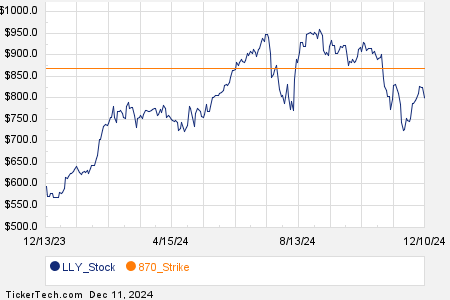Surging Options Activity Highlights Key Players in the S&P 500
Remarkable Trading Volumes for Eli Lilly, Visa, and BlackRock
Looking at options trading in the S&P 500 index, Eli Lilly (Symbol: LLY) has attracted attention today with a total of 18,846 contracts traded, equivalent to about 1.9 million underlying shares. This trading volume represents 44.8% of LLY’s average daily volume of 4.2 million shares over the past month. A significant portion of this activity involves the $870 strike call option, set to expire on December 20, 2024, where 770 contracts have exchanged hands, translating to around 77,000 shares. The chart below illustrates LLY’s trading history over the past year, with the $870 strike marked in orange:

Visa Inc (Symbol: V) has also seen noteworthy trading volumes today, recording 24,263 contracts, which equates to approximately 2.4 million underlying shares. This figure constitutes 43.2% of V’s average daily trading volume of 5.6 million shares for the past month. The $320 strike call option expiring on December 13, 2024, has garnered attention, with 9,509 contracts traded—representing around 950,900 shares. Below is the chart detailing V’s trading history, highlighting the $320 strike in orange:

Meanwhile, BlackRock Inc (Symbol: BLK) recorded an options trading volume of 2,912 contracts, translating to approximately 291,200 underlying shares. This figure reflects about 41.1% of BLK’s average daily trading volume of 708,240 shares over the past month. The $1000 strike put option expiring on February 21, 2025, has attracted significant interest, with 500 contracts traded, representing roughly 50,000 shares. The following chart shows BLK’s trading history, with the $1000 strike highlighted:

For more information on the various available expirations for LLY, V, or BLK options, visit StockOptionsChannel.com.
![]() Today’s Most Active Call & Put Options of the S&P 500 »
Today’s Most Active Call & Put Options of the S&P 500 »
Also see:
• Zoetis 13F Filers
• GDEN Average Annual Return
• XPER shares outstanding history
The views and opinions expressed herein are the views and opinions of the author and do not necessarily reflect those of Nasdaq, Inc.

